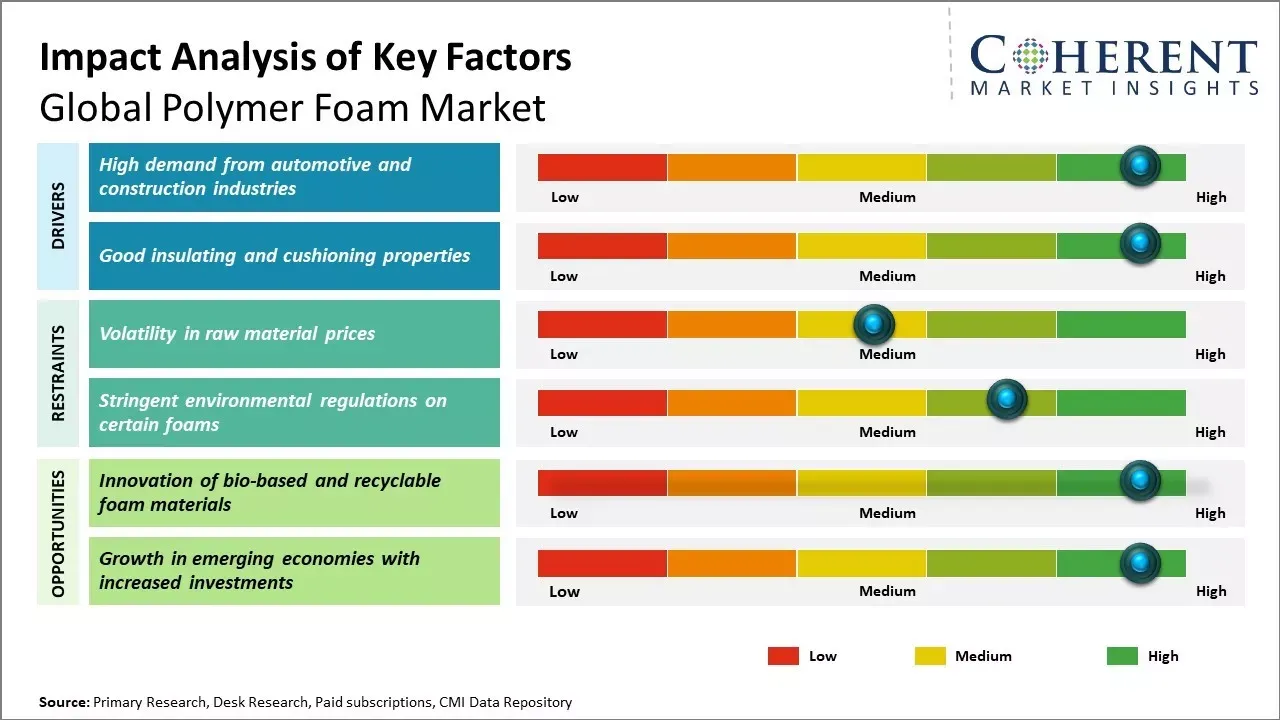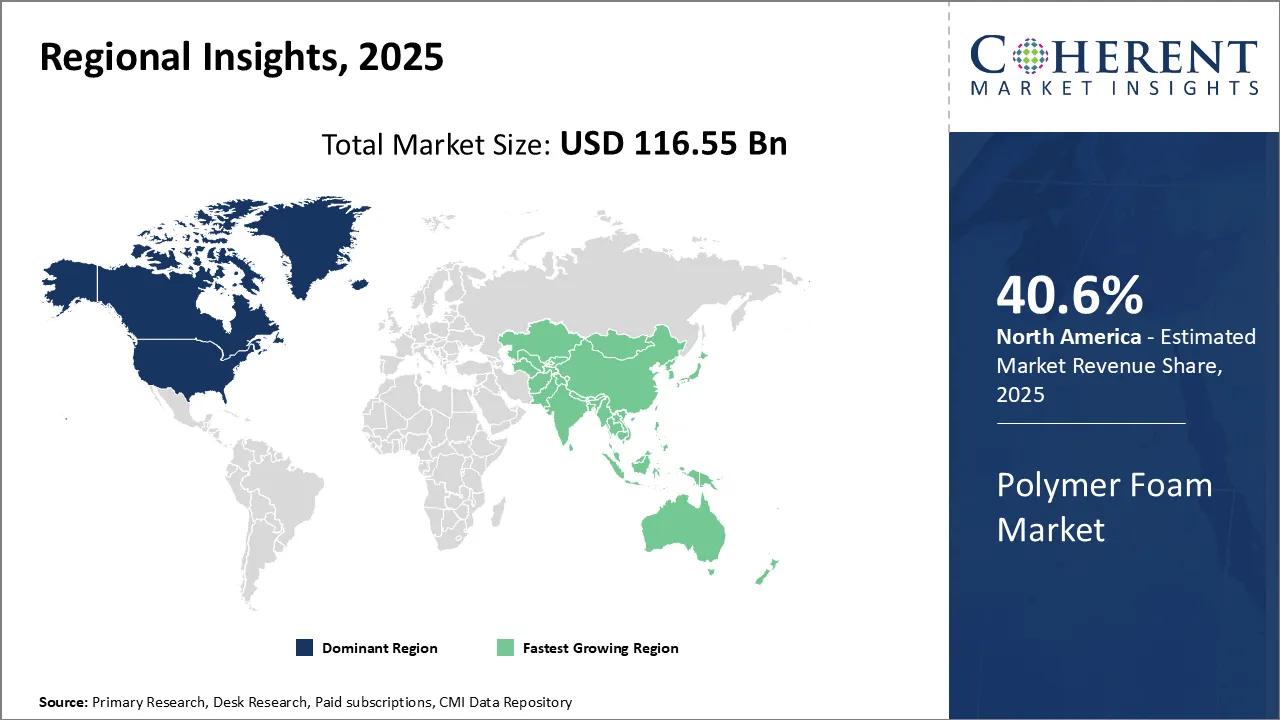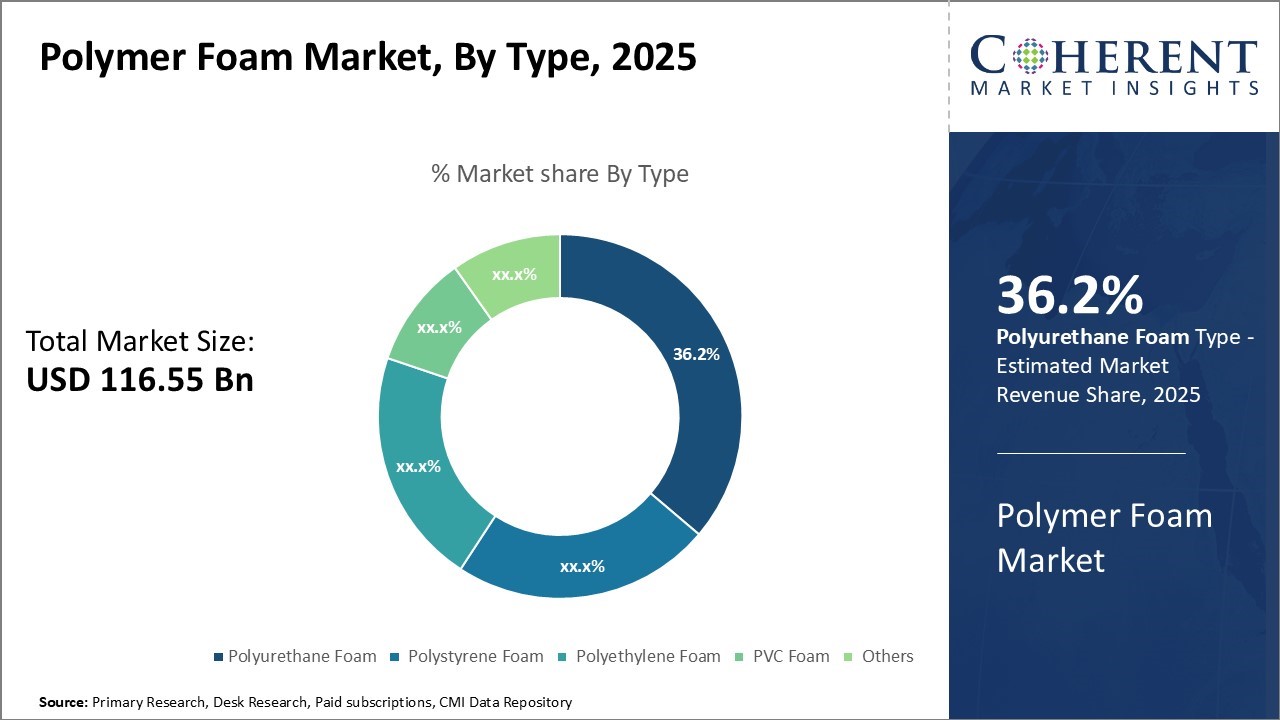Polymer Foam Market Size and Share Analysis - 2025 to 2032
Global polymer foam market is estimated to be valued at USD 116.55 Bn in 2025 and is expected to reach USD 167.41 Bn by 2032, exhibiting a compound annual growth rate (CAGR) of 5.3% from 2025 to 2032.

To learn more about this report, Download Free Sample
Key Takeaways
- By Type, the polyurethane (PU) foam segment is estimated to hold the largest share of 36.2% in the global polymer foam market by 2025, owing to its remarkable versatility and adaptability across industries.
- By Application, the packaging segment is projected to lead the polymer foam market with a dominant share of 40.2% in 2025, driven by surging e-commerce activity and a growing demand for protective, lightweight, and cost-effective packaging materials.
- North America is expected to remain the leading region in the global polymer foam market with an estimated 40.6% share in 2025. The region’s dominance is attributed to its robust demand from construction, automotive, and packaging industries, particularly in the United States.
Market Overview
The global polymer foam market is witnessing steady expansion, driven by rising demand across industries such as packaging, automotive, construction, and furniture. Lightweight, durable, and insulating properties make polymer foams ideal for applications requiring energy efficiency, shock absorption, and cost-effective materials. Polyurethane foam leads the market due to its versatility, particularly in insulation and cushioning.
Current Events and Its Impact on the Polymer Foam Market
|
Current Event |
Description and its impact |
|
Surge in Demand for Sustainable Packaging Materials |
|
|
Light weighting Initiatives in Automotive and Construction Sectors |
|
|
Raw Material Price Volatility and Supply Chain Disruptions |
|
Uncover macros and micros vetted on 75+ parameters: Get instant access to report
Polymer foam market Trends
- High demand from automotive and construction industries
Global polymer foam market growth is driven by huge demand for foams from automotive and construction industries. For instance, according to the data published by Trade Government, the U.S. boasts one of the largest automotive markets globally. In 2020, U.S. light vehicle sales reached 14.5 million units, solidifying the country’s position as the world's second-largest market for vehicle sales and production. Polymer foams are increasingly being used in various applications in automobiles such as instrument panels, seat cushions, doors, and others to reduce the overall weight of vehicles.
With global automakers focusing on meeting stringent fuel efficiency and emission standards, there has been growing emphasis on using lightweight materials in vehicles. Polymer foams are used due to their excellent weight to strength ratio compared to other materials. As automotive production increases across major markets like China, India, U.S., Germany, and others, there will be huge demand for polymer foams from this sector.
With growing construction of commercial and residential projects in developing nations in Asia and Africa and ongoing infrastructure projects across the world, there has been increase in usage of polymer foams in the construction of walls, roofs, doors and other areas. Their effectiveness in reducing energy consumption of buildings has further increased their popularity. As construction activity remains vibrant with steady growth in the future, it will drive the global polymer foam market growth.
In November 2024, The Times of India reported that researchers at the Indian Institute of Science (IISc), Bengaluru have developed a biodegradable polymer foam using non-edible oils and tea-leaf extracts. The eco-friendly foam, which biodegrades within hours, targets sustainable packaging applications. The article noted that India’s polymer foam market currently valued at USD 7.9 Bn is expected to reach US D11.1 Bn by 2032.
- Good Insulating and Cushioning properties
Polymer foams have been gaining popularity, owing to their unique combination of desirable properties. It provides excellent insulation against heat, cold, moisture, dust, noise, and other elements. Whether it is insulation in pipes, cooling containers, building walls or freezer insulation, polymer foams have become indispensable due to their high insulation effectiveness. This serves them very well in applications across various industries including construction, automotive, consumer goods, industrial goods and others.
Polymer foams show outstanding cushioning and impact resistance abilities, which have made them a preferred choice for applications requiring vibration dampening and shock absorption. For examples, these are extensively used in cushioning of automotive seats, footwear, mattresses, packaging materials, and other goods. Their light weight but solid structure helps provide effective protection against impact and vibrations. Some specialty foams also boast self-extinguishing properties, thus, making them suitable for applications with fire safety standards.
With their unmatched portfolio of insulation and cushioning qualities, polymer foams have penetrated diverse end-use sectors. As new applications emerge that capitalize on these attributes, there will be huge demand for polymer foams in the future.
In June 2025, The Times of India reported that the Central Citrus Research Institute (ICAR‑CCRI) in Nagpur has partnered with Visvesvaraya National Institute of Technology (VNIT) to develop biodegradable packaging films made from sweet orange peel waste. These bioactive, chitosan-alginate-based materials offer sustainable alternatives to conventional plastics and foams marking a significant step toward circular-economy packaging solutions.
Opportunities in the Polymer Foam Market
- Innovative bio-based and recyclable foam materials
Growing focus on sustainability presents a major opportunity for the global polymer foam market to develop innovative bio-based and recyclable foam materials. Customers are increasingly demanding eco-friendly products to reduce environmental footprint. Leading foam manufacturers have started investing in R&D to produce foams from renewable biomass sources instead of petroleum-derived polymers.
For example, developing rigid PU foams from polyols obtained from vegetable oils can help lower dependence on petrochemicals. The polymer foam industry has an opportunity to utilize recycled polymers from end-of-life foam applications to manufacture new foams, enabling effective material circulation. By adopting bio-based and recycling techniques, the industry can lower costs while enhancing brand value.
Sustainable foams have the potential to open up new application areas in industries such as automotive, construction, and packaging. To stay competitive, the polymer foam industry should capitalize on the sustainability trend and gain a strategic advantage through the development of eco-friendly products.
Global Polymer Foam Market Insights, By Type
The polyurethane (PU) foam segment is estimated to dominate the global polymer foam market with a 36.2% share in 2025, owing to its exceptional versatility and widespread application across multiple industries. PU foam is extensively used in cushioning for furniture, mattresses, and automotive seating due to its lightweight, flexible, and durable characteristics.
Additionally, its superior thermal insulation properties make it ideal for use in refrigeration systems and building insulation. The ability of PU foam to trap air within its cellular structure enhances both energy efficiency and acoustic performance. Rising demand for energy-efficient materials and advancements in bio-based PU foam production are further strengthening its position as a sustainable and cost-effective choice for manufacturers.
Global Polymer Foam Market Insights, By Application
The packaging segment is projected to lead the polymer foam market with a 40.2% share in 2025, driven by explosive growth in global e-commerce and rising demand for efficient protective packaging solutions. Polymer foams such as expanded polystyrene (EPS) and polyethylene (PE) are widely adopted for their excellent cushioning, thermal insulation, and shock absorption properties—crucial for shipping electronics, perishables, and fragile consumer goods.
As environmental sustainability gains traction, companies are shifting toward recyclable and biodegradable foam materials. This evolution, paired with increasing consumer expectations for safe and eco-conscious packaging, is positioning polymer foams as the material of choice in modern supply chains and logistics.
Regional Insights

To learn more about this report, Download Free Sample
North America Polymer Foam Market Trends and Analysis
North America is expected to remain the leading region in the global polymer foam market, accounting for an estimated 40.6% share in 2025. The region’s dominance is primarily driven by strong demand across the construction, automotive, and packaging sectors, particularly in the United States.
Polyurethane (PU) and polystyrene foams are extensively used in thermal insulation for buildings, automotive seating and interior components, and cold chain packaging for food and pharmaceuticals. Government regulations promoting energy efficiency and recyclable materials are accelerating the adoption of advanced foam technologies. Additionally, the presence of major foam manufacturers, coupled with ongoing R&D in sustainable and high-performance foam variants, is reinforcing North America’s leadership in the global market.
Europe Polymer Foam Market Trends and Analysis
Europe holds a significant share in the polymer foam market, supported by its strong environmental regulations and focus on circular economy practices. Countries such as Germany, France, and the UK are promoting energy-efficient building standards and automotive light weighting, both of which heavily rely on PU, phenolic, and expanded polypropylene foams.
The EU’s Green Deal and packaging waste directives are pushing manufacturers to develop recyclable and bio-based foam solutions. Moreover, Europe’s advanced cold chain logistics and high packaging standards in food and pharma sectors are further fuelling demand. With increasing R&D into low-emission foam production and stringent safety norms, Europe is positioned as a key innovator in the polymer foam landscape.
Polymer Foam Market Dominating Countries
United States and Canada
The United States remains a global leader in the polymer foam market, driven by high demand from the construction, automotive, and packaging sectors. U.S. manufacturers are at the forefront of developing polyurethane (PU) and polystyrene foam solutions that offer superior thermal insulation, durability, and lightweight properties.
Applications span across residential insulation, automotive interiors, and protective packaging for food, pharmaceuticals, and e-commerce. Government policies promoting energy efficiency and recyclable materials, along with a robust R&D ecosystem focused on sustainable and bio-based foams, solidify the country’s leadership.
Canada supports North America’s dominance through growing investment in green construction and eco-friendly packaging. The adoption of PU and expanded polystyrene (EPS) foams in building insulation and HVAC systems is increasing, bolstered by national energy efficiency standards. Canada’s focus on sustainable materials and its alignment with circular economy goals are fostering innovation in foam recycling and low-emission manufacturing.
Market Report Scope
Polymer Foam Market Report Coverage
| Report Coverage | Details | ||
|---|---|---|---|
| Base Year: | 2024 | Market Size in 2025: | USD 116.55 Bn |
| Historical Data for: | 2020 To 2024 | Forecast Period: | 2025 To 2032 |
| Forecast Period 2025 to 2032 CAGR: | 5.3% | 2032 Value Projection: | USD 167.41 Bn |
| Geographies covered: |
|
||
| Segments covered: |
|
||
| Companies covered: |
BASF SE, Dow Inc., Covestro AG, Sekisui Chemical Co., Ltd., Huntsman Corporation, Recticel NV, Armacell International S.A., Zotefoams plc, Sealed Air Corporation, Kaneka Corporation, Woodbridge Foam Corporation, Synthos S.A., Eurofoam Group, Sonoco Products Company, Foampartner Group, Carpenter Co., Foamcraft, Inc., FXI Holdings, Inc., Greiner AG, Rogers Corporation |
||
| Growth Drivers: |
|
||
| Restraints & Challenges: |
|
||
Uncover macros and micros vetted on 75+ parameters: Get instant access to report
Analyst Viewpoint
The global polymer foam market is driven by surging demand across construction, automotive, packaging, and furniture sectors. The material’s lightweight, insulating, and cushioning properties make it essential for applications ranging from thermal building insulation to protective e-commerce packaging and vehicle interiors.
- Experts highlight increasing adoption of polyurethane (PU) and polystyrene (EPS) foams in sustainable construction and green mobility solutions. Innovations in bio-based foams and recycling technologies are reshaping the market in line with global sustainability goals and regulatory pressure on material circularity.
- North America continues to lead the market, supported by well-established manufacturing ecosystems, stringent energy efficiency regulations, and strong demand from infrastructure and automotive industries. Asia Pacific, however, is expected to register the fastest growth, fuelled by rapid urbanization, smart infrastructure projects, and expanding e-commerce in countries like China and India.
Polymer Foam Market: Key Development
- In January 2025, A study introduced recyclable thin-film circuitry based on water-based polyurethane dispersions for smart packaging and e-skins. Opens new market avenues for polymer foams integrated with electronics, enabling reusable smart packaging and wearable tech, which may boost foam-polymer hybrid innovations.
- In March 2025, Useon and TotalEnergies Corbion announced a joint initiative to produce PLA-based EPLA foams for molded applications, including food packaging and insulation. Accelerates adoption of compostable, bio-based foam alternatives, addressing sustainability trends and regulatory pressure on EPS.
- In April 2024, BASF showcased circular economy initiatives at UTECH 2024, including chemical recycling of PU foam back to polyols. Enhances closed-loop foam production, reduces reliance on virgin petrochemicals, and supports sustainable manufacturing practices across automotive and insulation sectors.
- In June 2024, Cruz Foam introduced a compostable cold-chain foam made from up cycled shrimp shell chitin and other food waste, compatible with existing polystyrene infrastructure. Pioneers sustainable polystyrene replacements at scale, offering compostable insulation that decomposes in ~103 days—ideal for food and beverage cold-chain logistics.
Market Segmentation
- By Type Insights (Revenue, USD Bn, 2020 - 2032)
- Polyurethane Foam
- Polystyrene Foam
- Polyethylene Foam
- PVC Foam
- Others
- By Application Insights (Revenue, USD Bn, 2020 - 2032)
- Packaging
- Insulation
- Automotive
- Bedding & Furniture
- Others
- Regional Insights (Revenue, USD Bn, 2020 - 2032)
- North America
- U.S.
- Canada
- Latin America
- Brazil
- Argentina
- Mexico
- Rest of Latin America
- Europe
- Germany
- U.K.
- Spain
- France
- Italy
- Russia
- Rest of Europe
- Asia Pacific
- China
- India
- Japan
- Australia
- South Korea
- ASEAN
- Rest of Asia Pacific
- Middle East
- GCC Countries
- Israel
- Rest of Middle East
- Africa
- South Africa
- North Africa
- Central Africa
- North America
- Key Players Insights
-
- BASF SE
- Dow Inc.
- Covestro AG
- Sekisui Chemical Co., Ltd.
- Huntsman Corporation
- Recticel NV
- Armacell International S.A.
- Zotefoams plc
- Sealed Air Corporation
- Kaneka Corporation
- Woodbridge Foam Corporation
- Synthos S.A.
- Eurofoam Group
- Sonoco Products Company
- Foampartner Group
- Carpenter Co.
- Foamcraft, Inc.
- FXI Holdings, Inc.
- Greiner AG
- Rogers Corporation
Sources
The Stakeholders Consulted
- Manufacturers and distributors of polyurethane (PU), polystyrene (PS), polyethylene (PE), and phenolic foams
- Procurement managers and product development heads in construction, automotive, packaging, and furniture industries
- R&D heads from foam formulation labs and sustainable material research divisions
- Consultants specializing in sustainable building materials, lightweight automotive solutions, and cold chain packaging
- Regulatory experts on polymer usage, plastic waste management, and energy efficiency in insulation
- Government bodies involved in infrastructure, housing, and industrial development
- End-users across sectors including construction, automotive OEMs, FMCG packaging, furniture, bedding, and electronics
Databases Opened
- U.S. Environmental Protection Agency (EPA) – Green Building Materials and Recycling Stats
- PlasticsEurope – Annual Polymer Demand & Recycling Reports
- U.S. Census Bureau – Construction Spending and Housing Permits
- Indian Ministry of Chemicals and Fertilizers – Petrochemicals & Polymer Production Reports
Magazines & Trade Publications
- PU Magazine International
- Plastics News
- Foam Magazine
- Modern Materials Handling
- Automotive Manufacturing Solutions
- Packaging Europe
- Sustainable Plastics
Scientific and Industry Journals
- Journal of Cellular Plastics
- Polymer Testing
- Journal of Applied Polymer Science
- Construction and Building Materials
- Journal of Materials Science
- Composites Part B Engineering
Newspapers & Media Outlets
- Bloomberg – Manufacturing & Packaging Innovation
- Reuters – Automotive & Construction Sector Insights
- The Wall Street Journal – Chemicals and Raw Materials
- The Economic Times – Petrochemicals & Industrial Growth
- Business Standard – Sustainable Manufacturing & Recycling Trends
Associations and Regulatory Bodies
- American Chemistry Council (ACC) – Center for Polyurethanes Industry
- Plastics Industry Association (PLASTICS)
- Bureau of Indian Standards (BIS) – Foam and Polymer Standards
- European Chemical Industry Council (CEFIC)
- International Association for Plastics Distribution (IAPD)
- U.S. Green Building Council (USGBC)
Public Domain Sources
- U.S. Energy Information Administration (EIA) – Building Energy Efficiency Reports
- European Commission – Packaging Waste & Circular Economy Legislation
- International Renewable Energy Agency (IRENA) – Materials in Energy-Saving Technologies
- United Nations Environment Programme (UNEP) – Plastic Waste and Sustainable Packaging
Proprietary Research Elements
- CMI Data Analytics Tool
- Proprietary CMI Repository of Market Data (covering foam usage trends, applications, and forecasts)
- CMI Expert Interviews and Transcripts (covering insulation standards, automotive material innovations, packaging demand, and foam recyclability)
Share
Share
About Author
Vidyesh Swar is a seasoned Consultant with a diverse background in market research and business consulting. With over 6 years of experience, Vidyesh has established a strong reputation for his proficiency in market estimations, supplier landscape analysis, and market share assessments for tailored research solution. Using his deep industry knowledge and analytical skills, he provides valuable insights and strategic recommendations, enabling clients to make informed decisions and navigate complex business landscapes.
Missing comfort of reading report in your local language? Find your preferred language :
Transform your Strategy with Exclusive Trending Reports :
Frequently Asked Questions
EXISTING CLIENTELE
Joining thousands of companies around the world committed to making the Excellent Business Solutions.
View All Our Clients

